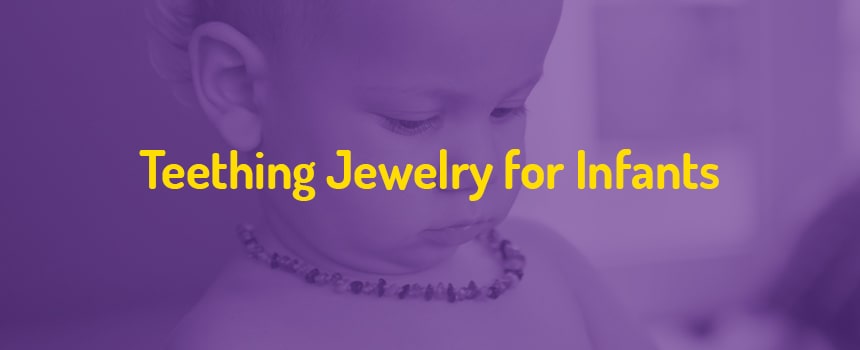Use the links below to jump to sections in this post to learn more about teething jewelry for infants.
- Why Teething Jewelry Is so Popular?
- Does Teething Jewelry Work?
- The Risks Associated With Teething Jewelry
- Teething Remedies That Are Effective and Safe for Little Mouths
Teething is a natural part of a child’s development, but it comes with a lot of pain and discomfort. No parent wants to see their child in pain, so most parents are eager to try anything that will keep their child comfortable and ease the pain of teething.
This desire to ease the pain and frustration of teething has prompted the rise in popularity of teething jewelry. Teething jewelry is exactly what it sounds like — child-sized jewelry designed to ease the pain that comes when teeth begin to push through a child’s gums.
Teething jewelry is usually made from marble, silicone, wood or amber. Amber teething necklaces for infants are perhaps the most popular among parents because of the prevailing belief that amber contains an anti-inflammatory chemical that’s released when the beads warm up against a child’s body.
While teething jewelry has become increasingly popular, the U.S. Food and Drug Administration (FDA) released a warning in 2018 against the use of teething jewelry because of its high risk for choking and strangulation, as well as the lack of evidence that it works.
The American Academy of Pediatrics (AAP) also recommends not using teething jewelry.
Weighing the FDA teething jewelry warning against colloquial evidence is confusing for many parents. After all, if your best friend or your neighbor swears by amber beads, isn’t that more important than a report on the internet? Do teething necklaces work?
Let’s take a look at this phenomenon and then you can decide for yourself.
How to Prepare for Your Child’s First Dental Visit
Why Teething Jewelry Is so Popular
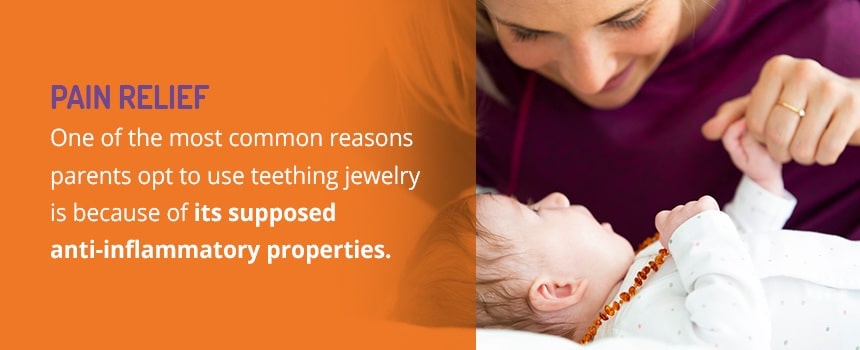
Teething jewelry for babies is increasingly popular among parents of young children because many parents believe that it eases the pain and discomfort associated with teething. If the baby’s not happy, no one’s happy. So parents are often willing to do whatever it takes to keep their baby content. But what is it exactly that teething jewelry is believed to accomplish?
1. Pain Relief: One of the most common reasons parents opt to use teething jewelry is because of its supposed anti-inflammatory properties. Amber jewelry is especially popular for this reason. What is amber? It’s fossilized tree resin whose oils contain a small amount of a chemical called succinic acid. Succinic acid has been marketed as a natural painkiller, an alternative to acetaminophen (Tylenol) typically recommended by pediatricians and dentists. Amber is also believed to be an effective way to reduce drooling and inflammation, two other side effects of teething.
Pain relief is also associated with teething jewelry because the necklaces, bracelets and anklets are designed with materials that provide some relief when children chew on them, such as wood or silicone. The material provides counterpressure against their sore gums and temporarily eases the pain they feel. This is the same relief a child would experience chewing on a spoon or a block, but since they’re wearing it as jewelry, they have quick and easy access, rather than waiting for mom or dad to dig a teething ring out of the bottom of the diaper bag.
2. Alternative to the Real Thing: Babies use their mouths to explore the world around them long before they can walk. Anything they see goes in there, especially once they start chewing on things to relieve the discomfort associated with teething. This means that mom’s jewelry often ends up in their mouths. Rather than risk breaking mom’s jewelry or choking on beads, teething jewelry is billed as a safer alternative for moms to wear while their baby is young.
3. Sensory Stimulation: Many people also find that teething jewelry offers sensory benefits for infants, as well as children with special needs. Nursing infants can use teething jewelry that helps them to focus while they’re feeding, a problem that arises as children become more aware of the distractions around them during mealtime.
For children with special needs, teething jewelry is often used to prevent them from chewing on their clothes or body parts. Teething jewelry can also provide the necessary sensory stimulation for children with ADHD or autism as they get older. Again, convenience is a big factor because jewelry is worn on the body. Rather than remembering to pack other sensory items or hoping a child has one nearby when they need it, jewelry goes with the child wherever they go.
Does Teething Jewelry Work?
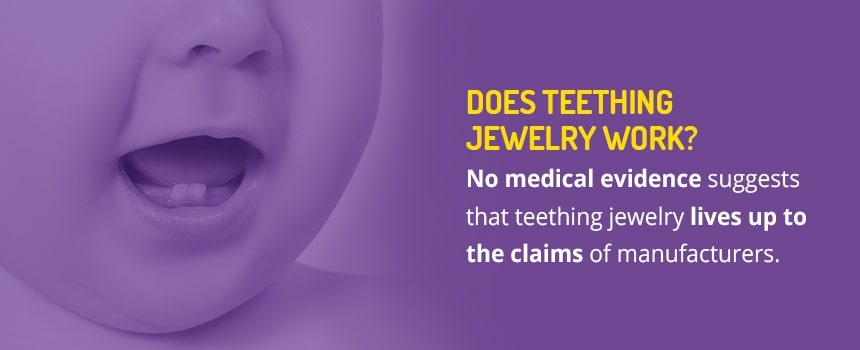
The short answer is no. Teething jewelry does not work.
No medical evidence suggests that teething jewelry lives up to the claims of manufacturers. Can amber relieve teething discomfort? A child may experience temporary relief after wearing amber beads, but there have been no studies that conclude that there is a medical reason for this relief. And, while there’s a lot to be said for the positive impact of sensory experiences for children with special needs, there are other ways to accomplish this besides teething jewelry.
Some parents question whether or not ingesting the succinic acid that’s released from amber can potentially harm their baby. The answer to this is also “no.” Succinic acid is not harmful in small doses.
However, as we stated before, there is simply no medical evidence available to suggest that it benefits children in any way. What many parents also don’t realize is that the heat of their child’s skin is not enough to release any significant amount of succinic acid from the amber. So the odds of getting any into their body, let alone enough to ease their pain, are incredibly slim.
The other problem with teething jewelry is that it poses a significant choking and strangulation hazard for infants and small children. Even jewelry that is designed to be “safe” can still break off in a child’s mouth or become tangled somehow. This brings us to our next point.
The Risks Associated With Teething Jewelry
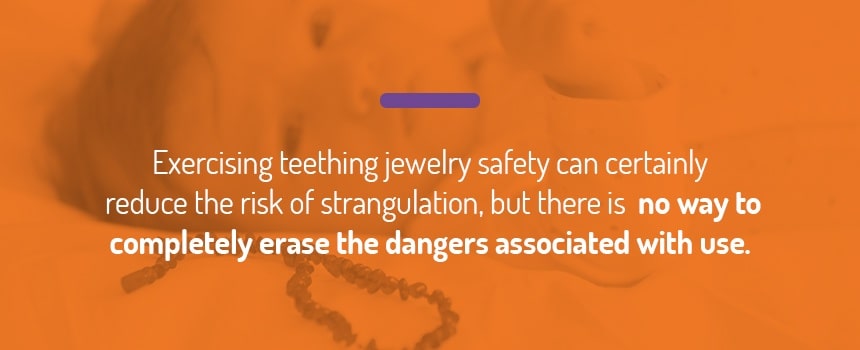
There’s no evidence that teething jewelry works, but parents also ask, Is teething jewelry safe?
Besides being an ineffective way to soothe aching gums, teething jewelry puts children at risk for serious injury or even death, even when it’s billed as safe for children. What are the risks of teething jewelry?
1. Choking: You won’t always be able to prevent foreign objects from entering your curious baby’s mouth, but teething jewelry is something you can and should control. Teething jewelry places your child at unnecessary risk by putting a choking hazard right in front of them. Teething jewelry — whether a necklace, bracelet or anklet — is made up of beads. If the jewelry breaks apart or a bead itself breaks, the pieces can easily be swallowed and become lodged in a child’s airway. Yes, technically children aren’t supposed to be chewing amber beads, but every parent knows that even beads that aren’t meant for chewing can and will end up in a child’s mouth at some point.
As evidenced by the FDA warning, even children who are using teething jewelry under parental supervision are still at risk. It only takes a few seconds for a bead to break in a child’s mouth and be swallowed. The FDA announcement doesn’t offer specific numbers of injuries and deaths related to choking, but it has received enough reports of teething jewelry deaths that it’s clear there is a problem at hand.
2. Strangulation: Sadly, children have been strangled by their teething necklaces. In their 2018 warning against teething jewelry, the FDA reported that an 18-month-old child had been strangled during his nap by a teething necklace. Other occurrences were inferred in this announcement as well. So how can a baby be strangled by a short necklace? All it takes is for the necklace to get stuck somewhere, especially if a child is left unsupervised while wearing the necklace.
Parents who opt to use a teething necklace for infants are advised never to leave it on their child during naptime, bedtime or any period of time when their child is out of sight. Exercising teething jewelry safety can certainly reduce the risk of strangulation, but there is no way to completely erase the dangers associated with use.
3. Injury and Infection: Teething necklaces are designed to handle a lot of wear and tear, but there’s no guarantee that they won’t break. Even if you purchase a high-quality piece, it’s quite possible for a bead to crack or break from constant handling. Broken teething jewelry injury is a possibility because there’s always the chance that it could scratch a child’s mouth, leaving them susceptible to infection, as well as the additional pain of having a sore in their mouth.
Teething Remedies That Are Effective and Safe for Little Mouths
Wondering how to relieve teething discomfort?
We wish there were an easy answer, but there’s no magic solution that will take away all your child’s pain and discomfort during their teething phase.
Cutting teeth is difficult, and you and your child will probably lose some sleep over it. Even when parents are aware of teething jewelry risks, it can be tempting to use it simply because you want your child to be comfortable.
Rather than ignoring the risk of teething jewelry injury, consider another tried-and-true way to ease your child’s discomfort and help them through teething. Here are some AAP-recommended ways to ease teething discomfort:
- Massage Their Gums: Wash your hands and then use your knuckle or fingertip to gently massage your baby’s gums, especially in the area you know is inflamed. Don’t press too hard — apply just enough pressure to ease some of the pain. Be careful if you’re doing this after their first couple of teeth arrive — your little one could decide to nibble your finger while it’s in their mouth!
- All the Frozen Stuff: Babies do love to chew, especially when they’re teething. If you must hand them something to put in their mouth, consider a damp washcloth that’s been put in the freezer first. The cold will ease their aching gums, and there aren’t any small pieces they could potentially bite off and swallow.There are a lot of other cold options that your child will love too! You can put a spoon or pacifier in the freezer until it’s nice and cold, then give it to them to chew on. Ice water in a bottle or sippy cup is also a safe and easy way to get cold stuff into your child’s mouth.Or, if you don’t want to risk filling their belly of water instead of breastmilk or formula, you can offer them a bag of frozen breastmilk if you have a stash in the freezer. How’s that for a quick and easy way to thaw their next meal?If you’re looking for some ideas with nutritional value, consider investing in a mesh teether. These mesh bags can hold frozen fruit, such as peaches or bananas. Your child can gnaw on the fruit through the mesh so that they have something tasty to chew, but you don’t risk chunks of fruit breaking off and causing them to choke. Just be sure to wipe your child’s gums down after they’ve chewed because they will get some of the fruit into their mouth. Even infants need to avoid tooth decay!
- Teething Toys: Teething rings and toys made out of rubber, wood or plastic can offer baby relief because they provide counterpressure on their gums when they bite down on them. Some teethers also come with bumps or ridges on them that can massage aching gums. These toys are typically easy to spot if you’re shopping in the infant and toddler section of any store, but if you still aren’t sure if a toy is large enough to safely act as a teether, consider its size. If it’s small enough to fit inside the tube of a roll of paper towels, then it’s too small for your child.
- Medicine At some point, you might need to give your baby acetaminophen to ease their discomfort. This is a perfectly normal part of teething and is a safe option to use to help baby through the worst of teething. Check with your pediatrician for the appropriate dosing, especially if your child hasn’t had acetaminophen before. Topical medicines used to be commonly used for teething, but they’re no longer recommended because they contain the anesthetic benzocaine, which is unsafe for children under the age of 2. These medicines are still sold in stores, but avoid the urge to use these to help baby feel better.
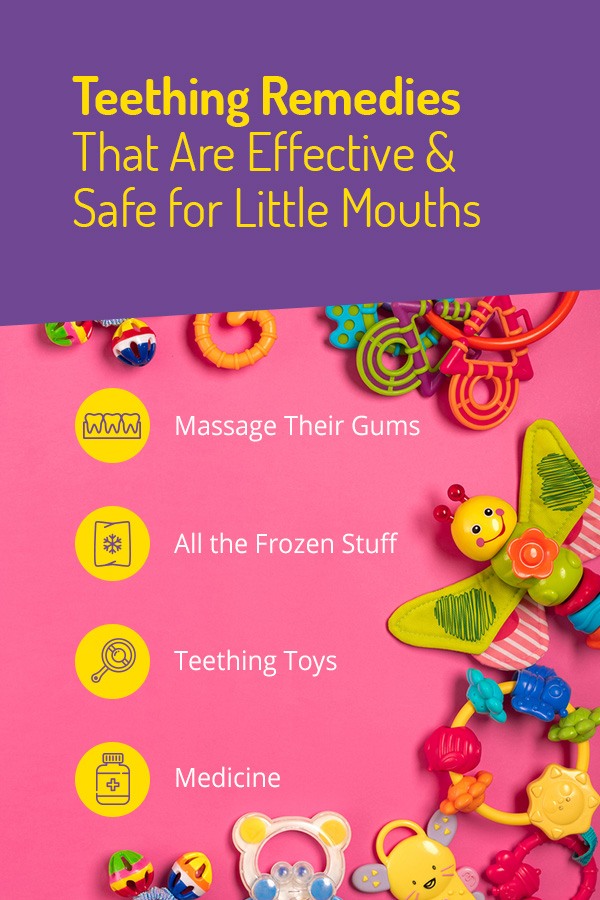
Fox Kids Dentistry & Orthodontics
Teething jewelry is an increasingly popular option among parents looking to keep their little one comfortable during teething. But it’s just not a safe or effective way to manage the pain that comes when a baby’s teeth are appearing. There are many other safe and effective options for keeping your baby happy during this time.
Whether you’re a first-time parent or you’re an old pro, it’s important to have a trusted pediatric dentist you can call with questions about teething and your child’s dental health — even from day one.
Serving families in and around the Portland area, Fox Kids Dentistry & Orthodontics is committed to providing you with quality pediatric dentistry from your child’s first tooth until their first day of college.
We specialize in pediatric dentistry because we know firsthand the value of taking care of even the tiniest of mouths. And we’re committed to setting your child up for a lifetime of good oral health.
If you’re in the market for a pediatric dentist, consider Fox Kids Dentistry & Orthodontics. Visit us online and schedule your child’s first appointment today!
